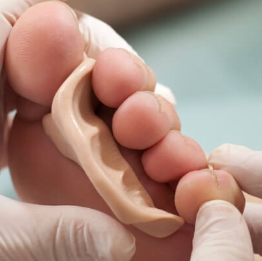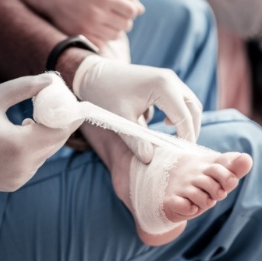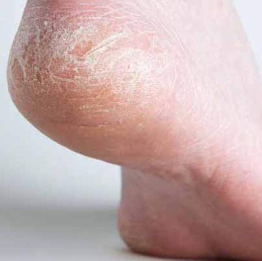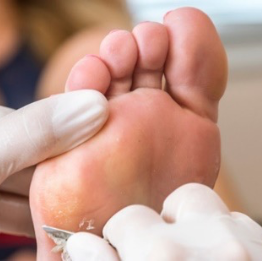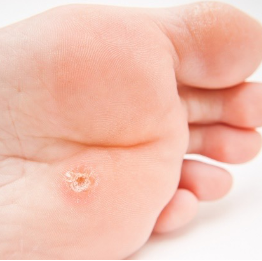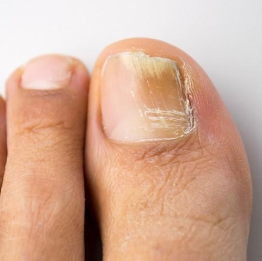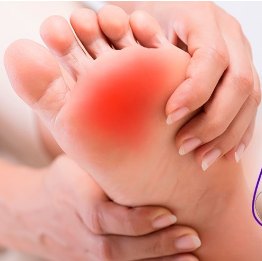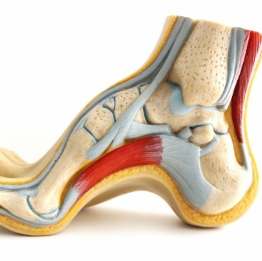PODIATRY IN MARBELLA
For the prevention, diagnosis and care of the foot, we carry out different treatments, which are adapted to the needs of each patient to guarantee their result.
Chiropodology
Diabetic foot
Scar Treatment
Geriatric Podiatry
Children's Podiatry
Nail Surgery
Sports Podiatry
Gait Analysis
Elaboration of Custom Insole
Diode Laser Therapy
Ingrown toenail
Ingrown toenail occurs when the corners of the nail curve downward and grow improperly into the skin (edge of the toe), causing pain and swelling.
Causes
The most common cause of ingrown toenail is improper cutting of the nail. Rounding off the nail or cutting it too short can make it easier for the skin around the finger to lift up and wrap around the nail. Wearing tight shoes or doing activities that put excessive pressure on the toes can also cause the nail to ingrown.
Symptoms
Pain, swelling, and redness around the affected area are the most common symptoms. An ingrown toenail can also become infected, causing a strong odor or drainage of pus around the inflamed area.
Athlete's foot
Athlete’s foot is a fungal infection that usually begins between the toes and develops with a scaly rash that usually causes itching, stinging, and burning. Athlete’s foot is contagious and can be spread through contaminated surfaces, towels, or clothing.
Athlete’s foot is closely related to other fungal infections such as ringworm and jock itch. It can be treated with over-the-counter antifungal medications, but the infection often recurs.
Symptoms
Athlete’s foot usually causes a scaly red rash that usually starts between the toes. The itching is usually worse right after removing your shoes and socks.
Some types of athlete’s foot can present blisters or ulcers, and even chronic dryness and peeling on the sole that extends to the sides of the foot.
Toenail Fungi
Nail fungus is a common problem that can affect people of all ages, although it most often affects older people.
Toenail fungus often begins as a skin infection called tinea pedis. The fungus often begins under the crease of the nail and over time, grows under the nail and causes changes in its appearance, such as a yellowish or brownish discoloration. It can also cause thickening and deformity of the toenail.
Plantar warts or Papillomas
This podiatric condition occurs when the human papillomavirus enters the body through cuts or breaks in the skin. Plantar warts are not dangerous, but they can be painful and resistant to treatment.
Causes
Plantar warts are caused by contact with the human papillomavirus (HPV), which is usually found in warm, humid areas such as showers or swimming pools. Many people get the virus by walking barefoot in public places. The wart is a buildup of skin that forms when the body’s immune system tries to fight the virus.
Symptoms
A plantar wart looks like a small, grainy bump on the sole of the foot, much like a corn. The bump may have small black dots inside it, which are clotted blood vessels. The wart can also cause foot pain when walking.
Calluses
Corns are the body’s attempt to protect itself from friction or pressure, but unfortunately, the extra skin becomes a painful problem in many cases. They are most common on the heel, ball of the foot, and on the sides of the foot.
Calluses on the feet are often caused by friction and pressure from footwear, as well as abnormal patterns during walking or repetitive activities such as sports.
Dry feet
Repairing and hydrating podiatric treatment with hyaluronic acid for cracked heels, fissures or dry skin on the feet.
These are alterations suffered by a large percentage of the population, causing pain, itching, cracks, redness, peeling and in some cases bleeding.
Wound Care
Ulcers are open wounds in the skin that occur when the outer layers of the skin are injured and the deeper tissues are exposed. Ulcers are commonly seen in patients with diabetes, neuropathy, or vascular disease.
Causes
Excess pressure due to tight footwear.
Long periods of bedridden.
After injuries that crack the skin.
Podiatric Treatment:
Elimination of unhealthy tissue and performance of local podiatric care in the wound.
Evaluation and care of shoes or special pads.
Prescription of antibiotics in case of infection.
Silicone Orthosis
Individualized preparation of silicone orthoses as a palliative and corrective means in foot conditions such as hallux valgus (bunion) or claw toes.
We offer Physiotherapy home visits. Call us now on +34 951 569 268, we will do our best to help you!

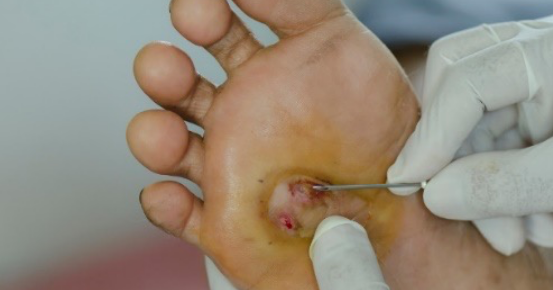
DIABETIC FOOT
Podiatry in Marbella, we specialize in the prevention, diagnosis and treatment of Diabetic Foot.
Causes:
Diabetes is the leading cause of non-traumatic lower extremity amputations. Anyone with diabetes can develop a foot ulcer, recognized as an open sore or wound that occurs in approximately 15% of patients with diabetes and is commonly located on the sole of the foot.
Patients with diabetes for many years can also develop peripheral neuropathy, causing a reduced or total ability to feel pain in the feet due to neurological damage, poor circulation, and foot deformities. Being overweight, alcohol and tobacco consumption also influence the development of foot ulcers. It is recommended periodically (2-3 months), to go to podiatric check-ups specialized in the maintenance and care of the Diabetic Foot.
We offer Physiotherapy home visits. Call us now on +34 951 569 268, we will do our best to help you!
Normotrophic scar
Normotrophic scar: scar that causes a tissue contraction and deforms the affected skin area. Neural therapy is indicated in this type of pathological scars, reducing pain and favoring the healing process, being effective in acute and chronic processes.
Neural therapy with Procaine is easy to apply and does not entail any adverse reaction, obtaining remarkable results from the first application.
Flat or normal scar
Flat or normal scar: imperceptible lesion with anatomofunctional integrity.
Keloid scar
Keloid scar: extends beyond the injury beyond the skin, and can cause burning and itching.
Atrophic scar
Atrophic scar: type of scar characterized by insufficient collagen production, causing the skin to sag in the area of the injury.
Hypertrophic scar: it exceeds the surface of the skin surrounding the wound, which can cause functional limitations and myofascial tension in joints or extremities.
We offer Physiotherapy home visits. Call us now on +34 951 569 268, we will do our best to help you!

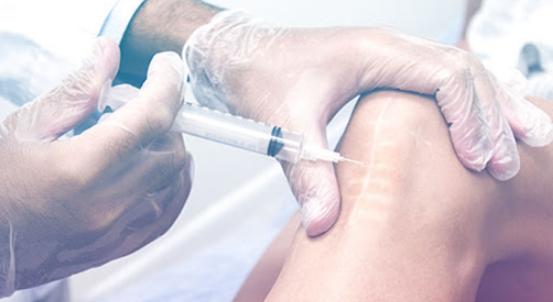

GERIATRIC PODIATRY
Exploration, active prevention and treatment of the foot in the elderly patient, in order to optimize and improve their well-being and autonomy.
Most common conditions in the geriatric foot:
Rheumatoid arthritisRheumatoid arthritis is a condition of the immune system that can cause damage to joints throughout the body, commonly affecting the foot and ankle, and can cause pain and instability.
Causes and Symptoms:
Causes:
The causes of rheumatoid arthritis are not fully understood. It can be caused by hereditary genetic factors, but environmental factors can also play a very important role in this pathology.
Symptoms:
Rheumatoid arthritis symptoms in the foot and ankle can include pain, swelling, and stiffness in one or both feet, and walking can become painful and difficult. As the disease progresses, other conditions can develop, such as calluses, bunions, hammer toes, claw toes, or flat feet.
We offer Physiotherapy home visits. Call us now on +34 951 569 268, we will do our best to help you!
CHILDREN'S PODIATRY
Foot clinic in Marbella specialized in early care and treatment of foot pathologies in children: flat feet-valgus, postural alterations ...
Children's Flat FootFlat feet are common in both children and adults. When this deformity occurs in children, it is called “pediatric flatfoot,” a term that encompasses several types of flatfoot. Although there are differences between the various forms of flat feet, they all share one characteristic: the partial or total collapse of the plantar arch of the foot. Most children with flat feet have no symptoms, but some children have one or more symptoms. When symptoms do occur, they vary depending on the type of flatfoot. Some signs and symptoms may include:
Symptoms:
Symptoms
- Pain, tenderness, or cramps in the foot, leg, and knee.
- Heel tilt outward.
- Clumsiness when walking
- Difficulty with shoes.
- Reduced energy when participating in physical activities.
- Voluntary withdrawal from physical activities.
El pie plano puede ser evidente al nacer o puede que no aparezca hasta años después, según el tipo de pie plano. Algunas formas de pie plano ocurren solo en un pie, mientras que otras pueden afectar ambos pies.
We offer Physiotherapy home visits. Call us now on +34 951 569 268, we will do our best to help you!

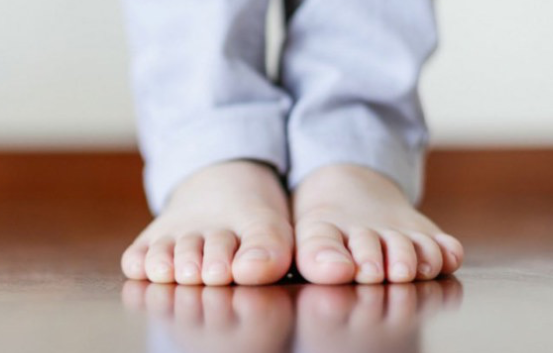
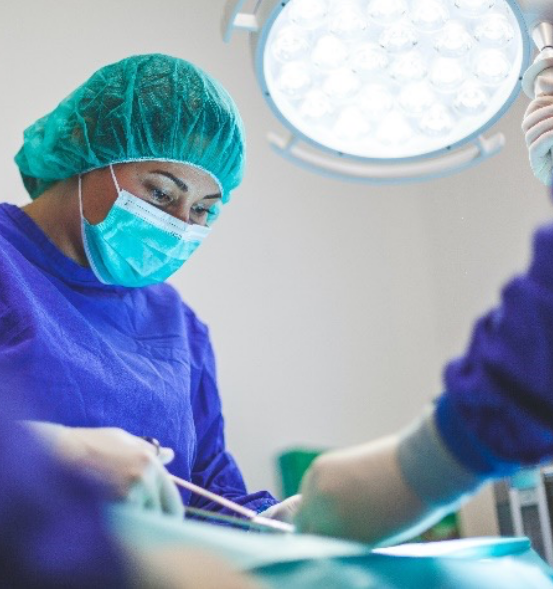
UNGUEAL SURGERY
Partial or total matriceptomy is a simple and outpatient surgical technique, under local anesthesia, indicated in the treatment of onychocryptosis or ingrown toenail. Matriceptomy is performed when conservative podiatric treatment such as spiculotomy or nail reeducation is ineffective, and the nail alteration becomes chronic.
Onychocryptosis or ingrown toenail is a nail disorder that can affect us in our daily lives, causing recurrent infections, discomfort and even functional impotence. This condition usually affects the first toe with a higher incidence, with only one or both nail canal incarnated.Causes:
The most common causes that predispose this pathology are:
- Bad nail trimming.
- Hyperhidrosis
- Use of shoes with a narrow fit.
- Nail morphology.
We offer Physiotherapy home visits. Call us now on +34 951 569 268, we will do our best to help you!
Different methods are used:
Different methods are used:
Comprehensive analysis of the biomechanics of gait and study of the footprint.
Manufacture of plantar orthoses or personalized insoles.
Recommendations for proper footwear and postural ergonomics.
Prescription of individualized therapeutic exercise in each pathology.
Un podólogo deportivo analiza la forma en la que el pie golpea el suelo y la cadena de movimiento ascendente que se desarrolla desde el pie hacia la rodilla, la cadera y la columna vertebral. El análisis pormenorizado de la cinética del movimiento determinará si existe algún desequilibrio mecánico que pueda contribuir a la existencia de una lesión.
We offer Physiotherapy home visits. Call us now on +34 951 569 268, we will do our best to help you!
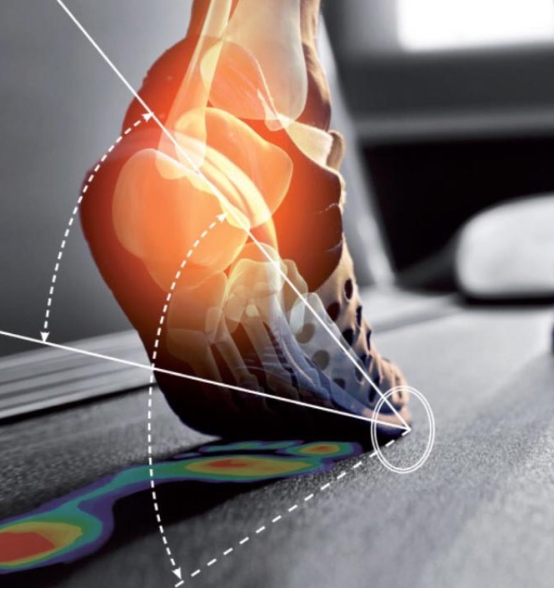
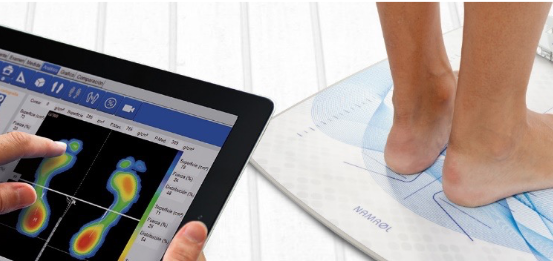
GAIT ANALYSIS OF CUSTOM INSOLE
Biomechanical Gait Analysis:Static and dynamic analysis of the plantar footprint, the distribution of pressures on the foot and the functionality of the lower limb joints.
Custom Insoles (Insoles:after an exhaustive study of the morphology of the footprint, personalized insoles are made to guarantee an improvement in the distribution of pressures on the foot and overall kinetics of the patient.
Most common conditions treated using custom templates:
- Calcaneal spur.
- Plantar fasciitis.
- Tendinopathies
- Mechanical or postural problems: low back pain, knee pain.
- Hyperkeratosis (calluses) and Helomas (calluses) on the foot.
- Symptomatic flat-cavus feet.
- Morton’s neuroma.
- Metatarsalgia.
- Claw toes.
Heel Pain
Heel pain is most often caused by plantar fasciitis, a condition that is also sometimes called heel spur syndrome when there is a spur causing the symptoms. Because there are several potential causes, it is important to properly diagnose the source of heel pain.
Plantar fasciitis
Plantar fasciitis is an irritation of the plantar fascia. This thick band of connective tissue runs along the sole of the foot between the toes and the heel. Supports the natural arch of the foot. It stretches and tenses each time the foot supports weight.
Causes:
Plantar fasciitis is caused by repetitive stress or excessive tension on the plantar fascia. Small tears may develop in this tissue, causing it to become irritated and inflamed.
Symptoms:
Plantar fasciitis pain feels like a shooting sensation in the heel of the foot. This pain usually develops gradually. It is usually worst in the morning, when a person takes the first steps out of bed. Plantar fasciitis can affect one foot or both feet.
Metatarsalgia
Pain and swelling in the ball of the foot. Activities with a high mechanical impact on the foot such as running or jumping or the use of inappropriate footwear can cause this pathology.
Although generally not serious, metatarsalgia can negatively affect your daily life. Fortunately, the use of appropriate footwear accompanied by the correct custom insoles that absorb the impact properly, or supports for the plantar arch, may be all you need to prevent or minimize future problems.
Symptoms
Sharp pain in the ball of the foot, the region of the sole of the foot just behind the toes.
Pain that worsens when bending the feet, walking or running especially barefoot on a hard surface, and improves when you rest.
Sharp or stabbing pain, numbness, or tingling in the toes.
Sensation of having a sharp element in the shoe.
Achilles tendinopathy
Also called the heel cord, the Achilles tendon facilitates the biomechanics of gait by helping to lift the heel off the ground. Achilles tendinopathy is an inflammation of the Achilles tendon. Over time, if not resolved, the condition can progress to tendon degeneration, in which the tendon loses its organized structure and is likely to develop microscopic tears.
Flatfoot
Flatfoot is described as the progressive collapse of the muscular structures and ligaments that support the plantar arch of the foot. This condition most often affects women and usually occurs in only one foot, but in some cases, both feet can be affected.
Symptoms
Sometimes adult flatfoot is painless. In others, the pain can be intense, focusing on the heel and inner arch of the foot. Activities that involve standing for a long time can aggravate symptoms and make your feet tire more easily. As the condition progresses, pain can travel even to the outer side of the foot and can trigger degenerative processes in the foot and ankle joints.
Cavo foot
Pes cavus is a condition in which the foot has a plantar arch that is too high, causing a disturbance in the distribution of pressures and an excessive amount of weight on the front of the sole of the foot and the heel.
Pes cavus can lead to a wide variety of signs and symptoms, such as pain and instability. It can develop at any age and can occur in one or both feet.
Causes
Hereditary or functional structural abnormality.
Neurological disorder such as cerebral palsy, Charcot-Marie-Tooth disease, spina bifida, polio, muscular dystrophy, or stroke.
Associated symptoms:
Hammer toes (flexed toes) or claw toes (toes clenched like a fist).
Calluses on the front of the sole, side or heel of the foot.
Pain when standing or walking.
Foot instability.
We offer Physiotherapy home visits. Call us now on +34 951 569 268, we will do our best to help you!
DIODE LASER THERAPY
What is laser therapy?
Laser therapy uses light safely and painlessly as a non-invasive, safe and effective treatment used to reduce pain, inflammation and stimulate wound healing.
Functionality of laser therapy
Laser therapy involves directing laser light energy at inflamed or damaged tissue to accelerate the body's natural healing process. The laser is placed in direct contact with the skin, allowing the photons of light to penetrate the tissue and interact with the molecules within the cells to cause several biochemical effects.
Indicated for physiotherapy and podiatry, treating conditions such as:
- Plantar warts (Papilloma Virus)
- Onychomycosis (fungal nail infection)
- Nail Surgery
- Wound Care
- Scars
- Plantar fasciitis
- Metatarsalgia
- Bone oedema
- Artritis Reumatoide
- Neuropathies


